Top News

April 19, 2017 Ryukyu Shimpo
On April 5, the Nature Conservation Society of Japan (NACS-J) and the Tokyo-based branding company ImageMILL held a screening event of the documentary film ZAN at Nago Civic Hall. The film addresses dugongs’ habitats in national natural monuments of Japan such as Oura Bay in the sea of Henoko, Nago City. Not only did the hearts of those who watched the film go out to the dugongs, their conviction to oppose land reclamation for the Futenma Air Station relocation plan’s new base was also renewed.
Zan means “dugong” in Uchinaguchi (Okinawan dialect). Tomoko Shimura of NACS-J explained, “We wanted local people to be the first to view [the documentary],” in regards to why Nago City, where construction of the new base is advancing, was chosen as the first ZAN screening location within Okinawa.
The film presented the facts that the practice of capturing dugongs for food has decreased in the postwar period, and that dugongs were historically prized as divine messengers. It also depicted fishermen’s tales and other legends about dugongs.
In addition, the film showed underwater photographs of the multitude of blue coral in Oura Bay, and of the concrete blocks now submerged in the bay.
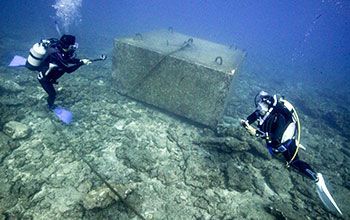
One scene from ZAN of a concrete block submerged in Oura Bay (photograph provided by ImageMILL)
ZAN director Richard Grehan gave a greeting, saying that there are many people who are indifferent to Okinawa’s situation. He mentioned that the team simplified the subject matter in order to reach Americans and a wider audience. Each day he hopes to reach many people with the film.
Eighty-one-year-old ZAN viewer Masamtsu Nakaima of Nago City drew attention to stopping base construction with the following statement: “We cannot allow coral and creatures this magnificent to be buried. This ocean does not belong only to Okinawa; it is an asset for Japan as a whole.”
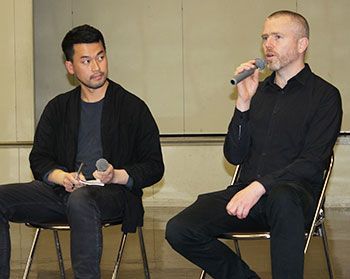
On April 5 at Nago Civic Hall director Richard Grehan (right) gives a greeting, joined by Yu Kisami who appears in the film.
Another viewer, 76-year-old Fujiko Matsuda of Teima, Nago shared her impressions as well. She said that even locals like her have only seen the beauty of the surface of the water, and viewing underwater images moved her deeply once more. In addition, she claimed an ocean so magnificent cannot be filled in for a base to be built. She went on to say, “I want everyone, both Okinawans and those outside of Okinawa, to watch [ZAN].”
(English translation by T&CT and Erin Jones)
Go to Japanese

April 19, 2017 Ryukyu Shimpo
By Chie Tome
“If you harass a mermaid you will be cursed.” The dugong was a model for the legends of mermaids and is a designated for special protection in Japan. There is much folklore about the dugong in Okinawa, and in every tale it is said that harming a dugong will invite misfortune. In Oura Bay in Nago, where traces of dugong feeding have been confirmed, there are plans to begin construction on land reclamation work in conjunction with the construction of a new base in nearby Henoko, and dugong lovers are expressing concern.
Oura Bay and Cape Henoko in Nago are known as one of the dugong’s few habitats. However, according to surveys conducted by the Okinawa Defense Bureau in conjunction with the new base construction, no dugong have been seen there since massive concrete blocks were sunk to the bottom of Oura Bay in January 2015.
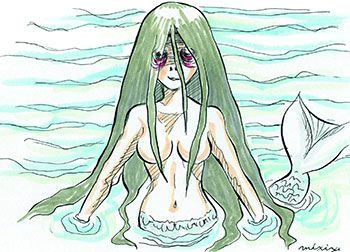
There are still legends of mermaids in Okinawa (illustration by Shizu Miki)
Takeshi Kohara, an author who wrote a section about dugong-related legends In the book “Illustrated Encyclopedia of Ryukyu Yokai”, says “It is also said that the 1771 Great Yaeyama Tsunami was divine punishment brought about by a dugong. If we threaten their living environment, there could be consequences.”
When we asked the Okinawa Defense Bureau about dugong legends, they replied, “We cannot respond to hypothetical questions. We want it to be understood that we are putting in our utmost effort to reduce the burden on Okinawa.”
Kiyomi Oshiro, 67, of Nago says she has heard tales of the dugong since she was a small child. “Who will benefit from purposely harassing [dugongs] and destroying their habitat? If human arrogance goes too far, we will pay the consequences someday,” says Oshiro.
(English translation by T&CT and Sandi Aritza)
Go to Japanese
April 20, 2017 Ryukyu Shimpo
Okinawa prefecture is making progress in revitalizing the techniques for making exquisite Ryukyu Kingdom-era arts and crafts with the Ryukyu Kingdom cultural heritage collection and restoration project. Making use of modern science and techniques, the project began in 2015 and will run through 2019. It aims to revitalize lost techniques and use them to create 65 works from eight different artistic fields including painting, wood-carving, stone carving, lacquer art, dyeing and weaving, ceramics, metal working, and sanshin. From 2019-2021, the reborn works will be displayed both in Okinawa and outside of the prefecture including locations abroad, presenting to the world the Dynastic brand with aspirations of creating a new hub of cultural tourism.
The seven works produced in 2016 include three types of crowns and a golden hairpin worn by the high priestess at court, and they will be on display at the Okinawa Prefectural Museum & Art Museum. An information session about the project’s 2016 accomplishments will be held at the same museum on April 30.
The project makes full use of its funding, the total cost of which in 2016 was 150 million yen. The Okinawa Prefectural Museum & Art Museum is in charge of the project, and in 2016 the Okinawa Churashima Foundation received the pieces on consignment. Around 60 workshops and artists from both Okinawa and elsewhere worked on the production of the works. The budget for 2017 is expected to be similar to the previous year.
While there were many cultural assets from the Ryukyu Kingdom era, many were lost in the Battle of Okinawa, and existing materials are scarce. In the project, prototypes are re-created based on existing artifacts and literature, and scientific analysis is performed with high-powered microscopes and x-rays in a continued search of the appearance and manufacturing methods of the lost items.
Researchers and creators in each of the fields hold periodic supervisory meetings in their respective fields, sharing progress and challenges, and making sure everything is academically corroborated.
Okinawa Prefectural Museum & Art Museum Curator Ken Sonohara, who is in charge of the project, said, “these works are what remain of the people who made them. I want to revitalize the beauty collected in these things, and share them with others.”
Okinawa Prefecture school superintendent Shojin Heshiki commented, “I feel that restoring the cultural assets lost in things like the fires from the Battle of Okinawa, and handing them down to Okinawans in generations to come has a lot of meaning.”
(Translation by T&CT and Sam Grieb)
Go to Japanese
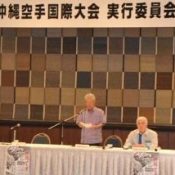
April 19, 2017 Ryukyu Shimpo
The Okinawa International Karate Tournament executive committee, which plans to host the 1st Okinawa International Karate Tournament in August 2018, held its second general meeting in Naha City on April 19.
The tournament will be held in kata category’s four divisions, Shuri-te/Tomari-te stye, Naha-te style, Uechi-ryu and Kobudou.
At the meeting, the tournament logo, posters, flyers and other matters were reported from subcommittees. A website for the tournament containing information about venues was set up at the end of March.
The executive committee will send caravans to European countries and elsewhere to promote the tournament from October this year to January next year.
It expects 5 to 6,000 participants from other prefectures and overseas to take part in events including seminars and exchange meetings.
(English translation by T&CT)
Go to Japanese

April 11, 2017 Ryukyu Shimpo
On April 10, the Okinawa Convention and Visitors Bureau (OCVB) unveiled Maharo-kun as a new mascot. Serving as a promotional ambassador for Okinawa together with Hanagasa Mahae-chan and the three Miss Okinawa beauty queens, he will work to draw domestic and foreign attention to the local charm of Okinawa as a tourist destination.
Maharo-kun’s backstory starts on Oahu Island in Hawaii. He is a third-generation Okinawan as his grandmother is from Okinawa, but he is from Honolulu. His first visit to Okinawa was to attend the 6th Worldwide Uchnanchu Festival. Maharo-kun says he has decided to move to Okinawa with the thought of becoming a bridge between Okinawa and the rest of the world, but it is clear the real reason is because he fell in love with Mahae-chan at first sight when he met her at the festival.
To pass the time Maharo-kun likes to surf, play ukulele, and practice karate. On the same day that he was introduced, he held an audience at the Okinawa Industry Support Center where he also demonstrated his ukulele and karate skills.
After this occasion Maharo-kun will attend exhibitions domestically and abroad to promote tourism to Okinawa. OCVB president Chokei Taira said, “I hope that introducing the new character will boost Okinawa’s image as a tourist destination.”
(English translation by T&CT and Erin Jones)
Go to Japanese
April 16, 2017 Ryukyu Shimpo
An accident which should never happen has happened in Onna. At the Afuso Dam construction site in the Camp Hansen Marine Corps base, damage that appears to have come from stray bullets was found in water tanks and the cars of dam workers.
When the stray bullets were fired, if there were people in the area, or if the bullets had gone in another direction, it could have caused a catastrophe. Stray bullet damage from Camp Hansen has occurred countless times since the end of WWII. It is obvious that this originates from the proximity of Okinawan residents and the base. The practice of live-fire exercises on the narrow island of Okinawa is in and of itself a mistake.
The Marines, who operate Camp Hansen and use it mainly for exercises, are inherently unnecessary in Okinawa. Considering the safety of Okinawan residents, the only option is for the Marines to return to the continental United States. If they truly need to conduct live-fire exercises, they would be better off conducting them on the expansive training grounds in the mainland United States.
According to representatives from Onna, Okinawa, and the Okinawa Defense Bureau, water tanks at the construction site were found empty on April 6, an what looked like bullets were discovered inside the tanks. On April 13, damage was found on the cars of workers who had parked at the construction site, and again, objects resembling bullets were found on the ground nearby.
Is any other place in Japan placed in such danger? At the House of Councillors Committee on Foreign Affairs and Defense on April 13, regarding the reduction of Okinawa’s base-hosting burden Prime Minister Shinzo Abe stressed, “The Abe administration has negotiated with the United States, and accomplished [a reduction in Okinawa’s base hosting-burden].” However, the “reduction” Abe speaks of consists of things such as the return of a majority of the Northern Training Area (NTA), which comes with the condition that a new helipad be constructed, and the clarification of scope of civilian personnel, the effectiveness of which is under scrutiny. Both of these “reductions” are only for appearances sake.
The reality in Okinawa is that there is no “reduction” whatsoever. The danger and overburdening still continue.
The main culprit is the Marine Corps, which is not letting go of their unnecessarily large training ground and continue to conduct dangerous training exercises. A real reduction would could in the form of the Japanese government demanding the withdrawal of the Marines.
Meanwhile, thinking back to the stray bullet incident in 2008 in Igei, Kin, you can see the Okinawan Police’s difficulties with enforcing the rule of law.
During the Igei incident, the U.S. military did not cooperate with the prefectural police officers and investigators inside the base for things such as voluntary questioning. The lopsided Status of Forces Agreement (SOFA) gives the U.S. primary jurisdiction while on-duty, blocking any revelations from coming out.
We cannot let the same incidents repeat over and over. It puts the lives of Japanese citizens in danger. The Japanese government has a responsibility to demand the cooperation from the U.S. military with investigations. The bullet-like objects have been collected by the U.S. military, and their involvement is clear. The Japanese and U.S. governments need to not only clarify areas of responsibility, but they need to seriously consider a plan to reduce the over-burdening of Okinawa.
(English translation by T&CT and Sam Grieb)
Go to Japanese

April 11, 2017 Ryukyu Shimpo
Okinawa Prefecture will send a written statement to request that the International Conservation Union for Nature Conservation (IUCN) and the other main environmental protection organizations in Japan reach out to the Japanese government to take measures to avoid environmental destruction caused by the construction of a new base in Henoko, Nago City. The sender of the opinion letters is Governor Takeshi Onaga. This is the first time for the prefecture to send letters to environmental groups about the Henoko base construction issue. On April 11, Vice Governor Moritake Tomikawa disclosed the news of the statement.
It contains a statement from Nago City Council. Nago City Council Chairman Minoru Yabiku and other members handed down a written statement passed by the Council on March 24. The written statement points out the influence that the construction of the new Henoko base will have on the environment of Oura Bay and asks the Japanese government and Okinawa Prefecture to request cooperation from IUCN.
Vice Governor Tomikawa said, “We would like to work together in collaboration with the prefecture and Nago City. The Japanese government refuses to listen even though IUCN has made recommendations four times. We want to send letters soon as the situation is getting tense.”
(English translation by T&CT and Megumi Chibana)
Go to Japanese
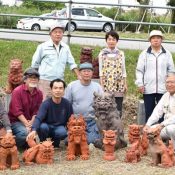
April 6, 2017 Ryukyu Shimpo
The association of landscaping with shisa placed fourteen shisa in front of the Nakagusuku castle ruins on March 29. This is the fourth project in which they have placed shisa statues after the Adaniya intersection, the Ogido old bus stop, and the Nakagusuku Kitanakagusuku fire station. The shisa statues are placed along the Adaniya intersection towards the Nakagusuku castle ruins, which are designated as World Heritage.
The project was done through a villagers’ participatory support system, and the group of shisa statues are named “Gosamaru shisa” in memory of the lord of the Nakagusuku castle. Fourteen members of the association took half a year to complete the shisa statues.
The leader of the association, Hanasaki, is motivated towards the group’s future activities. He said, “as an association we aim to improve the landscape of our village with shisa. If there are any requests to place more shisa, we would like to make them for anywhere in the village. We hope we can contribute to building our cultural Kitanakagusuku village.”
(English translation by T&CT and Sayaka Sakuma)
Go to Japanese
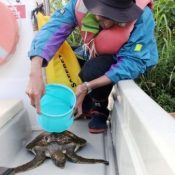
April 17, 2017 Ryukyu Shimpo
On April 14, in Oura Bay, Nago City, Tadashi Shimabukuro, 56, a member of the canoe team staging a protest against the construction of a new U.S. base, saved a sick green turtle.
According to Shimabukuro, the green turtle floated on the surface of the sea near pollution control membranes, which were installed in waters about 100 meters off the coast of Nagashima. “The turtle did not escape when I approached it. [The turtle] was likely unable to swim by itself, so I protected it.”
The Okinawa Churashima Foundation received notification about the turtle and sent a team to rescue it. They are now looking after it.
According to the team, there were no external injuries. The turtle is about 2-3 years old and its shell is about 40-cm long.
According to Shimabukuro, green turtles and loggerhead turtles have been often spotted swimming in Oura Bay.
“I do not know the direct cause of the debilitation,“ said Shimabukuro. He added, “The ocean environment has changed. It is more severe for living things.”
(English translation by T&CT)
Go to Japanese
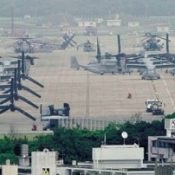
April 12, 2017 Ryukyu Shimpo
April 12 marked 21 years since the U.S. and Japanese governments agreed on the whole return of Futenma Air Station to Okinawa. Since the Futenma Air Station return plan set forth construction of a replacement facility in Henoko and therefore within Okinawa, Okinawans have continued to oppose relocation of MCAS Futenma within the prefecture. The governments of the U.S. and Japan are forcing through construction by asserting that the only solution to the dangers of Futenma Air Station is relocation of the base to Henoko. This month the first step of land reclamation in Henoko, which will be embankment work, is expected to start. As such, the contention between Okinawans and the Japanese government is becoming increasingly tempestuous.
Governor Takeshi Onaga is considering revoking the land reclamation permit and pursuing a legal request to suspend construction operations. However, he is not sure how effective these measures will be and understands there are risks such as incurring restitution claims. With these considerations in mind he is trying to find the right time to act. The Japanese government is also increasing pressure on Governor Onaga by hinting at the possibility of restitution claims against him.
In July 2016, the Government of Japan brought a lawsuit against the Okinawa Prefectural Government claiming that Governor Onaga’s cancellation of the land reclamation permit was illegal. Okinawa’s loss of the case was confirmed in the Supreme Court of Japan in December the same year, and construction into the ocean was resumed. At the end of March 2017, former governor Hirokazu Nakaima’s approval of coral fracturing expired. The Japanese government is expected to continue construction and plunge into embankment work while still unauthorized.
The Japanese government agreed to close Futenma Air Station operation within a 5-year period of February 2014, in answer to a request from the former governor Nakaima. However since Onaga took office, the Japanese government has tossed aside its previous promises and changed its tone, saying that the closure of Marine Corps Air Station Futenma is contingent on the prefectural government’s cooperation in moving forward with Henoko relocation.
(English translation by T&CT and Erin Jones)
Go to Japanese
April 13, 2017 Ryukyu Shimpo
Sri Sri Ra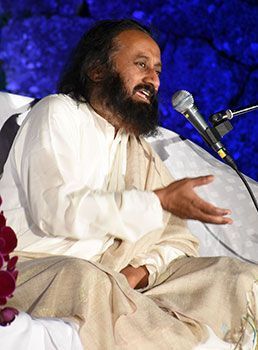 vi Shankar, 61, founder of The Art of Living Foundation, gave a speech at the Nakagusuku Castle Remains. The Art of Living Foundation is an international NGO centered in India that provides humanitarian and educational assistance all over the world. Shankar said in his speech, “Having inner peace will create peace everywhere,” and stressed the importance of Yoga and me
vi Shankar, 61, founder of The Art of Living Foundation, gave a speech at the Nakagusuku Castle Remains. The Art of Living Foundation is an international NGO centered in India that provides humanitarian and educational assistance all over the world. Shankar said in his speech, “Having inner peace will create peace everywhere,” and stressed the importance of Yoga and me
ditation. At one point in the speech, he even led the audience in meditation.
Shankar was nominated for the Nobel Peace Prize in 2006. Some of his lasting achievements include entering negotiations between the Colombian government and the Revolutionary Armed Forces of Colombia – People’s Army (FARC), which led to a ceasefire in the 50-year long conflict in Colombia. While promoting peace worldwide, Shankar also instructs Yoga.
Shankar also said, “When you touch the higher dimensions you will find an underlying unity in all the diversity… you will find that there is nothing other than you, everything is a part of you.”
He added, “W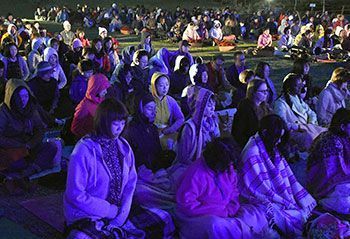 he
he
n you go to a higher dimension, you do not notice anything outside of your body. When the mind is small, you think small and as a result, you don’t communicate properly with people around you; there is friction. When you are in the big mind, your ability to communicate improves. In a state of enlightenment, there is no ‘other’ to talk about because everything is a part of you.’”
Shankar raised a number of examples of ways to achieve inner peace including (1) Having clarity in mind, purity in heart, and sincerity in action (2) Doing things useful to people (3) Keeping a smile (4) Meditation (5) Seeing the big picture in life. “We should not let our mind get stuck in events,
incidences and people. We have to sail through them all, and then our smile will be stronger.”
To the audience members, he said, “Today, leave your everyday worries and anxieties behind. I want you to go home thinking only the best things will happen.”
Speech planner Shinko Imai, 42, from Kita-Nakagusuku, said, “In Okinawa, with the base problem, although everyone wants peace, we find ourselves in a situation of opposition and conflict. There is diversity with all of us, and I want us all to respect one another.”
(English translation by T&CT and Sam Grieb)
Go to Japanese











 vi Shankar, 61, founder of The Art of Living Foundation, gave a speech at the Nakagusuku Castle Remains. The Art of Living Foundation is an international NGO centered in India that provides humanitarian and educational assistance all over the world. Shankar said in his speech, “Having inner peace will create peace everywhere,” and stressed the importance of Yoga and me
vi Shankar, 61, founder of The Art of Living Foundation, gave a speech at the Nakagusuku Castle Remains. The Art of Living Foundation is an international NGO centered in India that provides humanitarian and educational assistance all over the world. Shankar said in his speech, “Having inner peace will create peace everywhere,” and stressed the importance of Yoga and me he
he Webcam(Kokusai Street)
Webcam(Kokusai Street)


